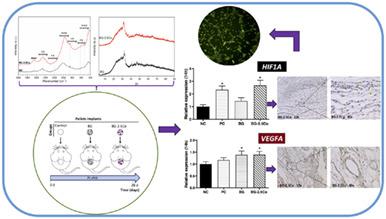当前位置:
X-MOL 学术
›
J. Biomed. Mater. Res. Part A
›
论文详情
Our official English website, www.x-mol.net, welcomes your feedback! (Note: you will need to create a separate account there.)
Cobalt‐containing bioactive glass mimics vascular endothelial growth factor A and hypoxia inducible factor 1 function
Journal of Biomedical Materials Research Part A ( IF 4.9 ) Pub Date : 2020-09-02 , DOI: 10.1002/jbm.a.37095 Andréia Grossi Santos de Laia 1 , Thalita Marcolan Valverde 2, 3 , Breno Rocha Barrioni 1 , Pricila da Silva Cunha 2 , Alfredo Miranda de Goes 2, 4 , Marcelo Coutinho de Miranda 2 , Dawidson Assis Gomes 2 , Celso Martins Queiroz-Junior 3 , Marcos Augusto de Sá 3 , Marivalda de Magalhães Pereira 1
Journal of Biomedical Materials Research Part A ( IF 4.9 ) Pub Date : 2020-09-02 , DOI: 10.1002/jbm.a.37095 Andréia Grossi Santos de Laia 1 , Thalita Marcolan Valverde 2, 3 , Breno Rocha Barrioni 1 , Pricila da Silva Cunha 2 , Alfredo Miranda de Goes 2, 4 , Marcelo Coutinho de Miranda 2 , Dawidson Assis Gomes 2 , Celso Martins Queiroz-Junior 3 , Marcos Augusto de Sá 3 , Marivalda de Magalhães Pereira 1
Affiliation

|
Bioactive glasses (BGs) have shown great potential for tissue regeneration and their composition flexibility allows the incorporation of different ions with physiological activities and therapeutic properties in the glass network. Among the many ions that could be incorporated, cobalt (Co) is a significant one, as it mimics hypoxia, triggering the formation of new blood vessels by the vascular endothelial growth factor A (VEGFA), due to the stabilizing effect on the hypoxia inducible factor 1 subunit alpha (HIF1A), an activator of angiogenesis‐related genes, and is therefore of great interest for tissue engineering applications. However, despite its promising properties, the effects of glasses incorporated with Co on angiogenesis, through human umbilical cord vein endothelial cells (HUVECs) studies, need to be further investigated. Therefore, this work aimed to evaluate the biocompatibility and angiogenic potential of a new sol–gel BG, derived from the SiO2–CaO–P2O5–CoO system. The structural evaluation showed the predominance of an amorphous glass structure, and the homogeneous presence of cobalt in the samples was confirmed. in vitro experiments showed that Co‐containing glasses did not affect the viability of HUVECs, stimulated the formation of tubes and the gene expression of HIF1A and VEGFA. in vivo experiments showed that Co‐containing glasses stimulated VEGFA and HIF1A expression in blood vessels and cell nuclei, respectively, in the deep dermis layer of the dorsal region of rats, featuring considerable local stimulation of the angiogenesis process due to Co‐release. Co‐containing glasses showed therapeutic effect, and Co incorporation is a promising strategy for obtaining materials with superior angiogenesis properties for tissue engineering applications.
中文翻译:

含钴生物活性玻璃模拟血管内皮生长因子 A 和缺氧诱导因子 1 功能
生物活性玻璃 (BG) 已显示出组织再生的巨大潜力,并且它们的组成灵活性允许将具有生理活性和治疗特性的不同离子结合到玻璃网络中。在许多可以掺入的离子中,钴 (Co) 是一个重要的离子,因为它模拟缺氧,由于对缺氧诱导物的稳定作用,触发血管内皮生长因子 A ( VEGFA ) 形成新血管因子 1 亚基 alpha ( HIF1A),一种血管生成相关基因的激活剂,因此对组织工程应用具有重要意义。然而,尽管具有良好的特性,但通过人脐带静脉内皮细胞 (HUVEC) 研究,掺入 Co 的玻璃对血管生成的影响仍需进一步研究。因此,这项工作旨在评估源自 SiO 2 -CaO-P 2 O 5的新型溶胶-凝胶 BG 的生物相容性和血管生成潜力。——CoO系统。结构评价显示无定形玻璃结构占优势,证实样品中钴的均匀存在。体外实验表明,含钴玻璃不影响 HUVECs 的活力,刺激管的形成和HIF1A和VEGFA的基因表达。体内实验表明,含钴眼镜可刺激VEGFA和HIF1A分别在大鼠背部真皮深层的血管和细胞核中表达,由于 Co 释放,对血管生成过程有相当大的局部刺激。含钴玻璃显示出治疗效果,并且掺入钴是获得用于组织工程应用的具有优异血管生成特性的材料的有前途的策略。
更新日期:2020-09-02
中文翻译:

含钴生物活性玻璃模拟血管内皮生长因子 A 和缺氧诱导因子 1 功能
生物活性玻璃 (BG) 已显示出组织再生的巨大潜力,并且它们的组成灵活性允许将具有生理活性和治疗特性的不同离子结合到玻璃网络中。在许多可以掺入的离子中,钴 (Co) 是一个重要的离子,因为它模拟缺氧,由于对缺氧诱导物的稳定作用,触发血管内皮生长因子 A ( VEGFA ) 形成新血管因子 1 亚基 alpha ( HIF1A),一种血管生成相关基因的激活剂,因此对组织工程应用具有重要意义。然而,尽管具有良好的特性,但通过人脐带静脉内皮细胞 (HUVEC) 研究,掺入 Co 的玻璃对血管生成的影响仍需进一步研究。因此,这项工作旨在评估源自 SiO 2 -CaO-P 2 O 5的新型溶胶-凝胶 BG 的生物相容性和血管生成潜力。——CoO系统。结构评价显示无定形玻璃结构占优势,证实样品中钴的均匀存在。体外实验表明,含钴玻璃不影响 HUVECs 的活力,刺激管的形成和HIF1A和VEGFA的基因表达。体内实验表明,含钴眼镜可刺激VEGFA和HIF1A分别在大鼠背部真皮深层的血管和细胞核中表达,由于 Co 释放,对血管生成过程有相当大的局部刺激。含钴玻璃显示出治疗效果,并且掺入钴是获得用于组织工程应用的具有优异血管生成特性的材料的有前途的策略。



























 京公网安备 11010802027423号
京公网安备 11010802027423号